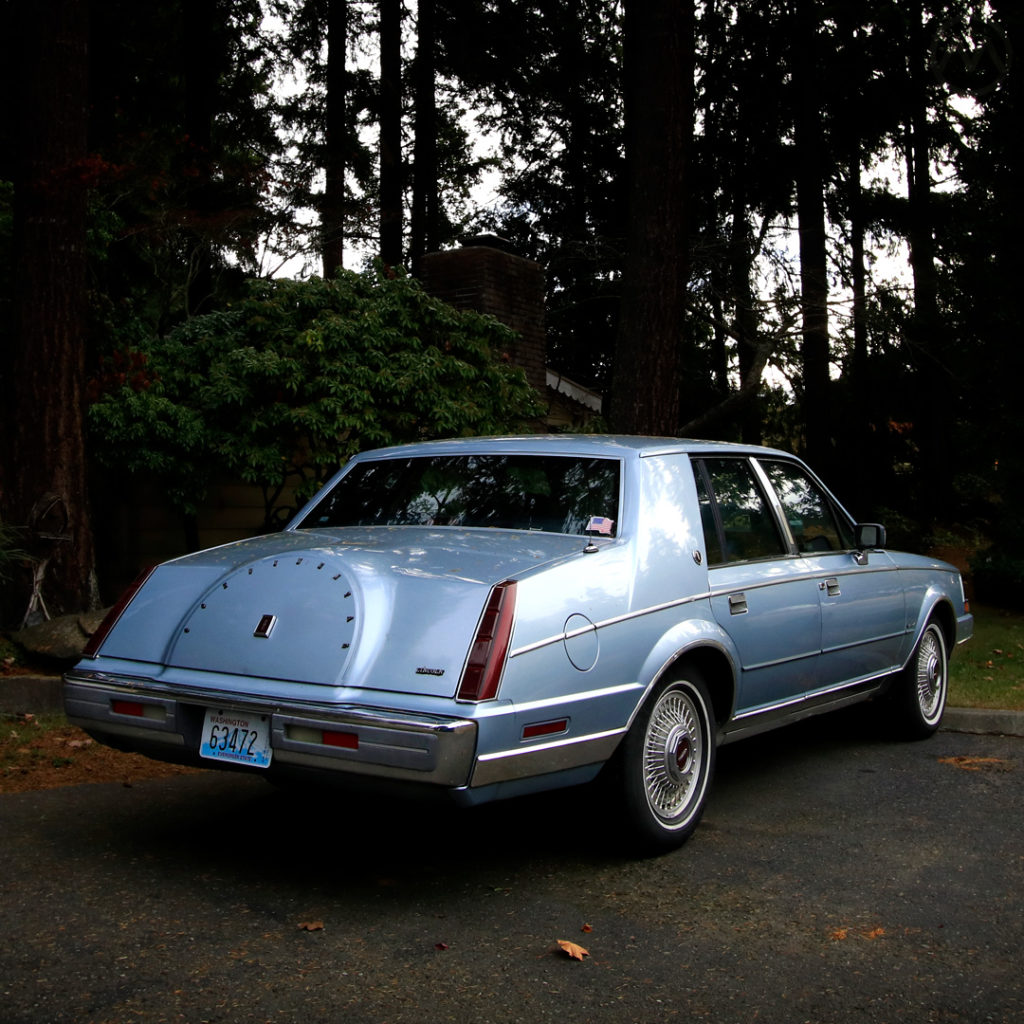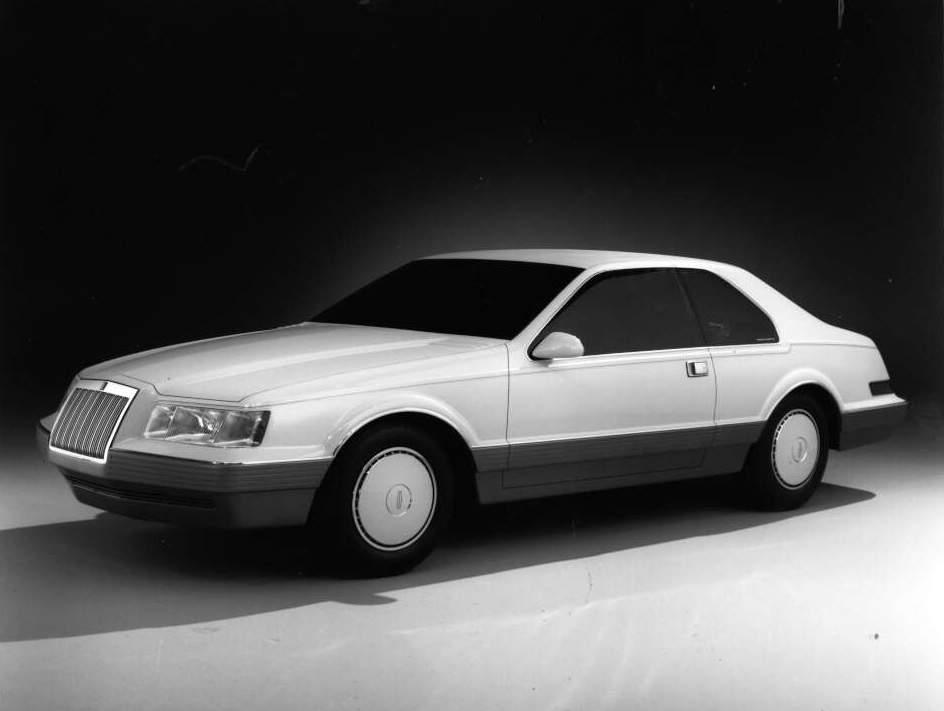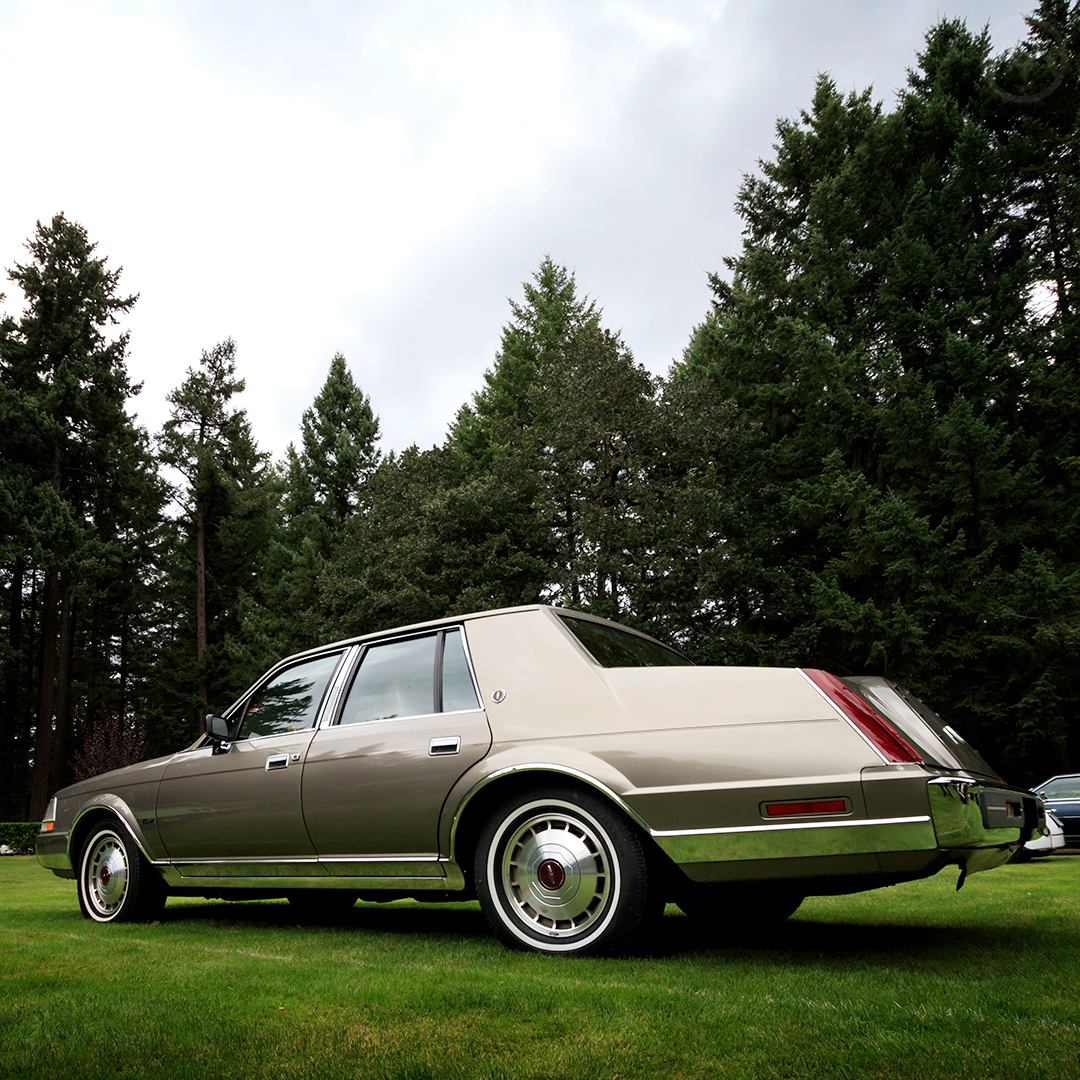Sometimes you lead, and sometimes circumstances dictate that you follow. In the case of the mid-eighties Lincoln Continental, the first downsized car to wear that name, Lincoln was definitely a follower.
In 1975, Cadillac’s “internationally sized” Seville caught Lincoln by surprise, though to be fair Ford’s luxury division was riding high on the MkIV at the time and had not yet felt the pinch of buyers defecting to imported cars. The division’s hastily-crafted response, the 1977 Lincoln Versailles, was almost universally panned as a dressed-up Mercury Monarch, which it was.
After that critical drubbing, it isn’t surprising that when it came time to replace it, Lincoln took a more deliberative approach. However, In crafting the Versailles’ replacement, Lincoln followed again. This time the hook it was mimicking was the distinctive “bustle back” made famous two years earlier by the second-generation Seville.
The 1982-87 Continental was created at a turbulent time within Ford, and one in which the humble “Fox” platform, originally designed for mainstream Fords, was underpinning a large slate of cars it was never really intended for, including the Mustang and the Thunderbird. So the Continental had to be appreciably differentiated from those cars and it had to please notoriously fickle luxury car customers. The safest way to avoid a repeat of the Versailles debacle may have been to take a bit of a me-too approach.
The story here really begins with that first Seville, a favorite among disco-era fashionistas. Although there were slightly slimmer coupes starting in the late 1960s, American luxury cars were generally land yachts of varying proportions from the 1930s until the 1975 Cadillac Seville. In one leap into the unknown Cadillac had created a genuinely desirable alternative to encroaching Mercedes-Benzes, although the Seville didn’t play to quite the same crowd.
The Seville proposal was greenlit in December of 1973 and to the delight of skeptical dealers and execs, proved to be a huge (and hugely profitable) hit. Lincoln had to respond.
The Versailles
Lincoln’s most successful 1970s model was the Mark series and beyond that huge car, Ford’s luxury division had no plans for anything smaller. At first, Ford Granada and Mercury Monarch advertising scoffed at the Seville’s towering price for what was a similarly-sized car, but 18 months later Lincoln launched the hastily-conceived Versailles.
Based directly on the Granada and Monarch twins, the initial Versailles looked far too much like its cheaper sisters. As those cars were full of fake wood trim and simulated opulence, the difference inside was also not so apparent. But the Versailles was an $11,500 car in 1977 (before options). That was twice the price of the V8 Monarch sitting in the same showroom.
It was true that the Seville shared much DNA with the humble X-body Chevrolet Nova, but customers could not easily see that relationship. The Seville’s touchpoints seemed unique outside and in. That made the Versailles seem very much like the cynical badge-up job that it was, and Lincoln-Mercury dealers had a hard time moving them.

Poor sales prompted a quick update in 1979, when the car got a more formal roof courtesy of a vinyl-disguised window extension (there was only so much that could be done to update the car without spending real money). That buoyed sales in 1979, but they crashed again in recessonary 1980.
Chrysler’s humbler LeBaron, similarly created from a cheaper mid-size car, fared better, but it was also far closer in price and character to the Monarch than the Seville.
1980 was a bleak year for American luxury cars. A second oil crisis and soaring inflation (bringing sharply rising vehicle prices and difficult loan terms) conspired against all cars but especially large ones, and these were both factors in bringing about a sharp recession.
Overall, industry sales fell by almost 30% from 1978 to 1981, but large cars like Lincoln’s full-size mainstays and Marks fared worst of all. Worse yet, an increasing slice of the luxury market pie was going to Mercedes, BMW, and newer upstart Audi. The Versailles went out of production along with its cheaper siblings in 1980, but into the void Lincoln would have to come up with something. Just as the Versailles was petering out, Cadillac introduced its second-generation Seville.
Bustlebacks For Everyone
The sleek Seville, debuting with Diesel power as an option, seemed perfectly timed. It did, however, cause tons of controversy with its love-it-or-hate-it styling, done by GM designer Wayne Kady and actually dating to around the time of the first Seville.
The defining feature of the car was the “Bustleback” rear, supposedly patterned on British limousines of the 1930s and 1940s, and specifically a Hooper-bodied Rolls-Royce. One of the old-school British bustles, the Daimler DS420, was actually still in production in the 1980s, but it was very different in character.
The sloping back of the car made for more style than cargo room, but irrespective of suitcases fitting in it, it got lots of attention, both good and bad. It looked like nothing else on the road, but quickly spawned imitators. In 1981, when Chrysler decided to revive the Imperial name on a big coupe, that car debuted with a more modest bustle.
In the meantime, Lincoln had briefly put off replacing the Versailles, concentrating first on the downsized “Panther” Lincolns of 1980, designed under Gail Halderman. The entire line was new for 1980, with the MkVI now sharing its architecture with the Continental, itself to soon be relabeled “Town Car.”
The second iteration of the Versailles was already under development. Some sources say that it was initiated under long-time Ford Design boss Gene Bordinat, but Bordinat retired in 1980 and probably wasn’t around for the finishing touches. Exactly who penned the car isn’t clear at the time of this writing, but among the stylists who worked on it was Howard Payne, who was primarily an interior designer.

Lincoln’s new small entry would be based on existing architecture as with the Versailles – in this case, the now ubiquitous Fox body platform, introduced as the 1978 Ford Fairmont and Mercury Zephyr.
The Fox was a good platform and easily adaptable to many configurations – from the Mustang to the Thunderbird to Mercury Cougar station wagons. It was quiet, cheap to make, and it allowed easy use of a multitude of engines, though only three would end up featuring in the new Lincoln. Initial offerings were the 3.8L “Essex” V6 and the 302 V8.
Given the relatively humble origins of the mechanical pieces, Lincoln was very careful to make the car look as unlike the other Foxes as possible. Although the front clip bore some resemblance to the Cougar/Monarch, the body shell seized on the bustleback look, undoubtedly because of all the buzz the new Seville had made in late 1979 and 1980.
The result came out looking sleek and well proportioned, riding on its own 108.5” (276 cm) wheelbase, not shared with any other “Foxes.” It was, however, clearly an imitator.
Although likely planned as a “Versailles,” the name was changed to Continental shortly before launch – probably to provide the car with a clean slate free of comparisons to that car. It was the smallest ever car to wear that label and the senior Lincoln sedan was renamed “Town Car” to suit.
The Small Continental and the Telnack Era
“Neoclassic” looks were very popular in the 1970s when the first two Sevilles were developed and even into the early 1980s, but during the Reagan Era they quickly started to give way to the “Aero Look.” Although he himself had designed quite a few frilly “broughams,” few American design chiefs were farther ahead on that curve than Ford’s Jack Telnack.
A Ford designer since 1958, Telnack had risen to Ford of Europe’s design VP before returning home in the late 1970s to lead development on what became the 1979 Mustang and the 1980 Thunderbird. Telnack had become Ford’s design chief a year later, replacing Bordinat. The sleek Mustang proved a hit, but the T-bird bombed, perhaps causing some rethinking in 1981-82 after the small Continental’s original look had been locked in.
A similar changing of the guard had taken place a year earlier when Philip Caldwell has succeeded Henry Ford II as Ford’s first non-family CEO since 1906.
In 1980 Caldwell instructed Telnack that a major re-think of Ford’s overall styling direction was needed. It was this conversation that ushered in the “Aero” Era at Ford, but a big ship takes a long time to turn. The first fruits of Telnack’s new direction (in the U.S.) would not appear until late 1982.
The new Continental had debuted in October, 1981, and had done well against the Seville, outpacing the Cadillac by 3,900 units and selling better than any of the years of the Versailles, with 24,000 cars sold. Almost all of them were V8s, and the V6 was quietly dropped at the end of the year.
The car debuted to good, if reserved, praise – it was not a match for BMW or Mercedes dynamically, but it did all the things a traditional American luxury car did in a more reasonably-sized package. Plus, it had none of the many high-profile engine foibles of contemporary Cadillacs or the fuel-injection woes of the Imperial. The Continental just ran, and didn’t complain.
The sales momentum did not continue in 1983, with sales falling to 17,000 cars, but by then the new era of Telnack cars was at hand.
Just a few months after the Continental’s debut, at the 1982 New York Auto Show, Lincoln displayed the “Continental Concept 90.” This sleek aerodynamic coupe looked like no other Lincoln before. Wildly streamlined, the lozenge-shaped car had only a token resemblance to any other Lincoln product but the idea, execs claimed, was to get the public acclimatized to the idea of such a radical aerodynamic Lincoln.

It looked like it could have come from Audi. ”We’re calling it Continental Concept 90,” an anonymous Ford executive said at the show, ”but that’s just a thin disguise. It really is the ’84 Mark VII, 90 to 95 percent the way it will appear.” The car also presaged the upcoming 1983 Thunderbird and Mercury Cougar, themselves re-skinned Foxes related to the unloved 1980-82 models mechanically.
At the time, Ford had a 113-day supply of Lincolns, a huge backlog of unsold cars. So while the dramatic 1984 MkVII was being readied, Telnack’s team decided to update the Continental sedan to match.
So it was that for 1984 the two-year-old car got an entirely new “aero” front end, though it still used sealed-beam headlights instead of the flush units that would define the MkVII. The V8 got fuel injection and, curiously an efficiency engine from an unlikely source was added. For 1984-85, a 2.4L BMW diesel six, from the 5-series, was optional – though rarely chosen.
The styling changes and the engine update did help sell cars, though this Continental would not pass the Seville again in the sales race. Since considerable funds had been spent on it in both 1982 and 1984, the car remained more or less unchanged into the fall of 1987.
Like other Lincolns, it was a luxurious car inside and characterized by high-level trims – Signature, Valentino, and a designer edition courtesy of Hubert Givenchy. In actuality, the Givenchy house had little do with the car, the styles were picked out and tailored for the car by Ford’s design staff, including Harold Payne.
Aside from the sometimes-troublesome air suspension, the Fox Continentals were durable and comfy, and later on, all the performance parts for Fox Mustangs could be applied (though most were always luxurious freeway wafters).

Transforming into Aero Modern
Now a car out of time in the Aero-look eighties, the Continental, even with its 1984 update, looked dated by 1987, at which time it shared the showroom floor with the Telnack-era all-star, the Mercury Sable. Just over 12,000 of the final year cars were sold.
The Taurus/Sable platform was used as the basis for the next iteration of the “small” Continental, the futuristic 1988 model, starting at the end of that year.
Buyers were indeed looking for “Aero modern.” The front-drive, Taurus-related ‘88 sold in much larger numbers than either the Versailles or the Bustleback Continental, hitting 47,000 units in 1988 and rising to over 60,000 in 1990.


I have a 1986 Lincoln continental they got hit in the front looking to part it out. Is that baby blue color with the dark blue interior